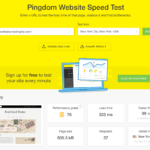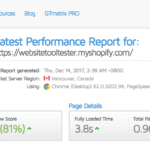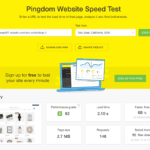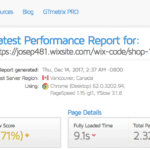Tooltester is supported by readers like yourself. We may earn an affiliate commission when you purchase through our links, which enables us to offer our research for free.
At first, the idea of this article almost seemed absurd. Who needs a comparison of apples and oranges?
The position has always been: Wix is a brilliant tool for regular websites. Shopify is the go to store builder.
Not much has changed for Shopify, they still focus 100% on ecommerce. Wix, however, has discovered that many of its users are looking for a simpler way to build an online store – simpler even than Shopify.
We are here to tell you which solution is right for your ecommerce site. So let’s see if the underdog has a few surprises in store (pun intended):
Rounds Overview
| Contents | Shopify | Wix |
|---|---|---|
| Ease of Use | Good | Excellent 🏅 |
| Themes and Flexibility | Great 🏅 | Good |
| Product presentation and features | Great 🏅 | Good |
| Payment options | Great 🏅 | Good |
| POS Capabilities | Great 🏅 | Good |
| Sales Channels | Good 🏅 | Ok |
| Customer Logins and Checkout Options | Good 🏅 | Ok |
| Working in a team | Good | Great 🏅 |
| Shipping Cost Settings and Carrier integration | Excellent 🏅 | Ok |
| Tax Settings | Excellent 🏅 | Great |
| Multilingual capabilities | Ok 🏅 | Poor |
| SSL (checkout on own domain) | Excellent | Excellent |
| SEO capabilities | Great 🏅 | Good |
| Pagespeed | Great 🏅 | Good |
| Customer Support | Great 🏅 | Ok |
| Market Place / App Store | Great | Great |
| Prices | Good | Great 🏅 |
| AI capabilities | Great 🏅 | Good |
Wix vs Shopify: What’s the main difference?
Wix offers beginner-friendly ecommerce features geared towards small online stores.
Shopify is suitable for much larger stores as it’s built to easily manage thousands of store items. Thanks to its language, payment and shipping options, it’s also easier to scale your store internationally.
Wix’s Core plan starts at $27/month whereas Shopify Basic is $29/month (annual plans).
Video Review: Wix vs Shopify comparison
> Try Shopify for free
> Try Wix’s free plan
If you still have some doubts about what’s your best option, read our comprehensive comparison below.
Wix vs Shopify in 17 Rounds of Tests
Round 1: Ease of Use – Which one is more user-friendly?
While Shopify claims to be the best solution for online stores, it never said it was the easiest to use. However, their user experience is so well-designed that you need very few clicks to create your first store in minutes. Adding products and variants is a breeze, and we love the way they link to tutorials – very useful for complete beginners. This is particularly helpful, because setting up a Shopify Store is quite a serious affair. You’ll need a good couple of hours minimum to configure everything right.

Wix’s backend
Wix, like many other solutions, also claims to be the best. But one point they really insist on is being super easy to use for creating websites and ecommerce stores. We agree. In fact, we’d happily call Wix one of the easiest website builders out there. Their user experience is excellent, and their tutorials and step-by-step guides are well written and easy to use.
Compared to Shopify, it’s much easier to style your content pages using Wix’s drag and drop functionality.
Adding an ecommerce module with their drag and drop editor is just as intuitive. And if you want to create an online store even faster, you can also use Wix ADI that employs artificial intelligence to produce a ready-made template in seconds.
Winner: Wix is hard to beat for ease of use. However, this is probably because their online stores are more basic than Shopify’s.
Shopify – Wix 0:1
Round 2: Themes and Flexibility – Who has the best ecommerce templates?
When it comes to creating your virtual storefront, Shopify certainly makes things easy with their approximately 150 themes. They are modern, sleek and responsive, so they look good on desktops and mobiles. Want to customize them? The live editor is great fun and gives excellent results. If you know CSS and HTML, you can also tweak them to your heart’s content.
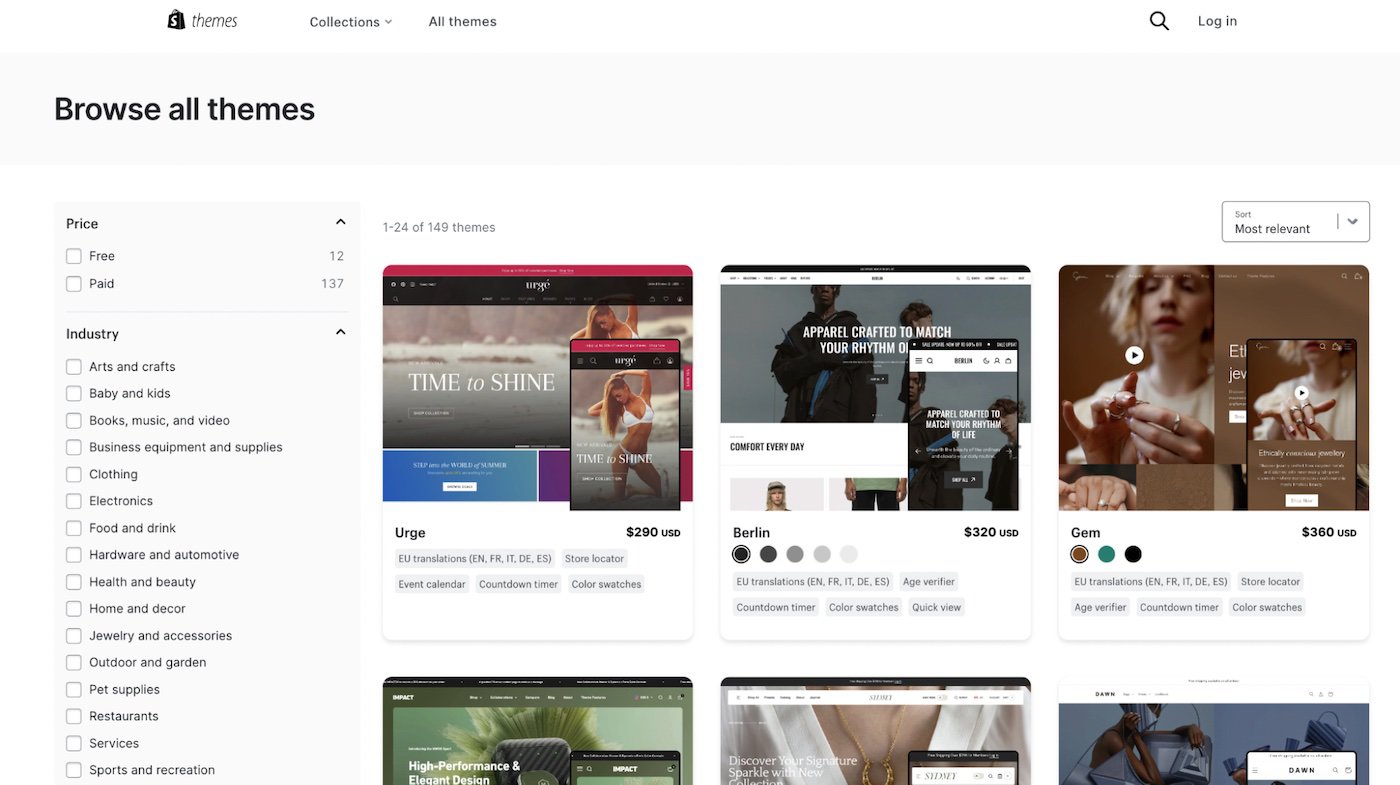
You can filter Shopify themes by price, industry, catalog size, and features to find the perfect fit.
The only snag is that you have to pay a one-time fee for most themes ($170 – $380) as only some of them are free (check out our pick of the best free Shopify themes). Veeqo has put together a few nice examples here.

Shopify’s free templates
Wix offers a whopping 800 free templates, including about 120 which are designed for ecommerce. They look as modern and stylish as Shopify’s, and we really like their catalog galleries (you can see some examples of them being used on real Wix websites here).
Unfortunately, Wix’s templates aren’t fully responsive, so you sometimes need to rearrange elements manually to display them on smartphones a certain way (Wix Editor X tries to solve this, although it still hasn’t quite taken off).
And while creating a website with Wix generally gives you tons of flexibility, in-depth customization via code such as HTML or CSS isn’t as complete as with Shopify (unless you use the not-so-popular Wix Velo, which is geared towards techy users).
Winner: The Shopify themes take the lead because they are responsive and ecommerce focused. This will allow you to customize the look of your store. Wix isn’t that flexible, especially with product pages.
Shopify – Wix 1:1
Round 3: Product Presentation and Features
Both Wix and Shopify limit the number of variants you can add per product. Shopify allows for three options per item (such as color, size, style), and a total of 100 unique variants. Wix allows for six options per item and a total of 1000 unique variants.
Having customers make six choices to buy a single item might complicate the purchasing process. Instead of overwhelming customers with 1000 options, it’s probably better to split products with many variants into separate listings. So we don’t see Shopify’s limit as a downfall, here.
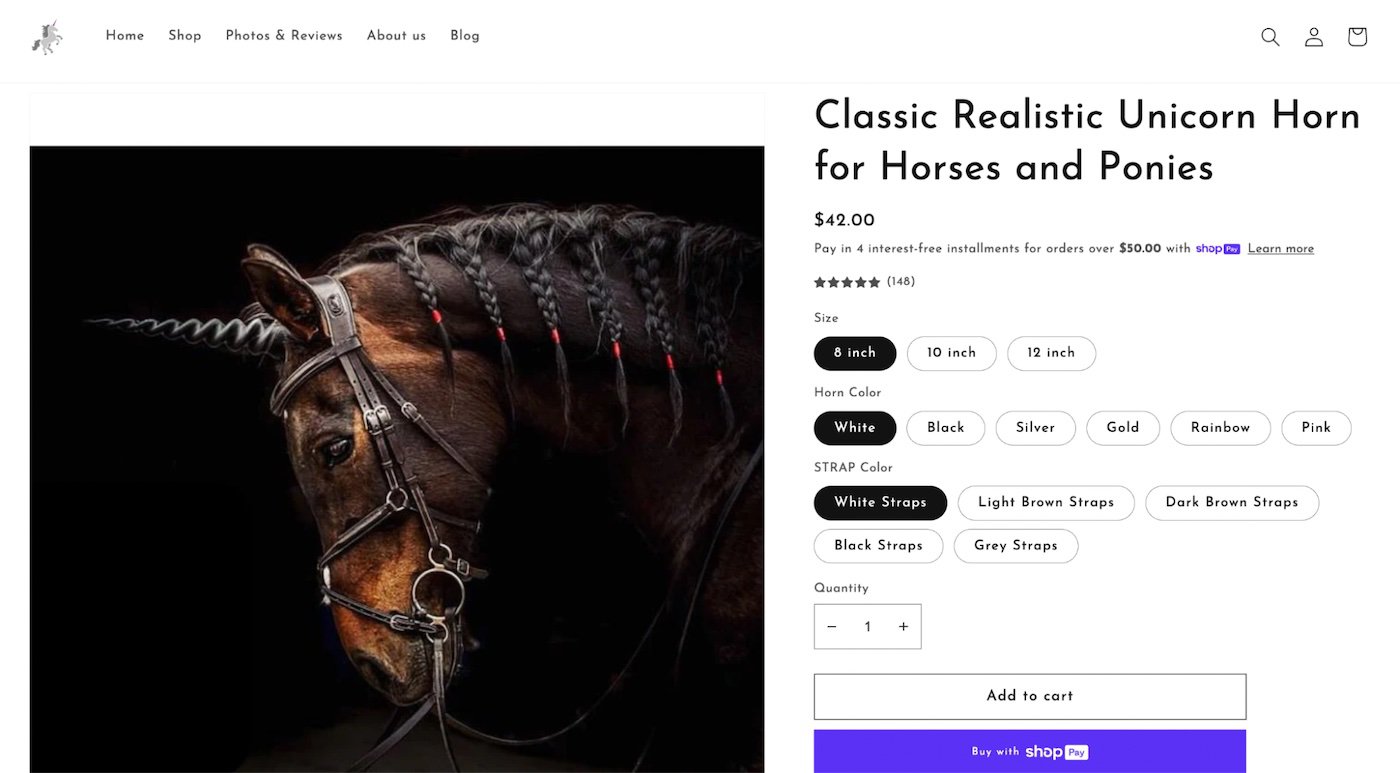
Unicorn Corner’s Shopify store offers a product with 3 options (size, horn color, and strap color) with a total of 90 unique variants. That’s enough choices for one item!
Both let you create titles, descriptions, and image galleries with cool zoom effects. But Shopify doesn’t (easily) allow for product customizations, ribbons, size charts or wishlists – while Wix does.
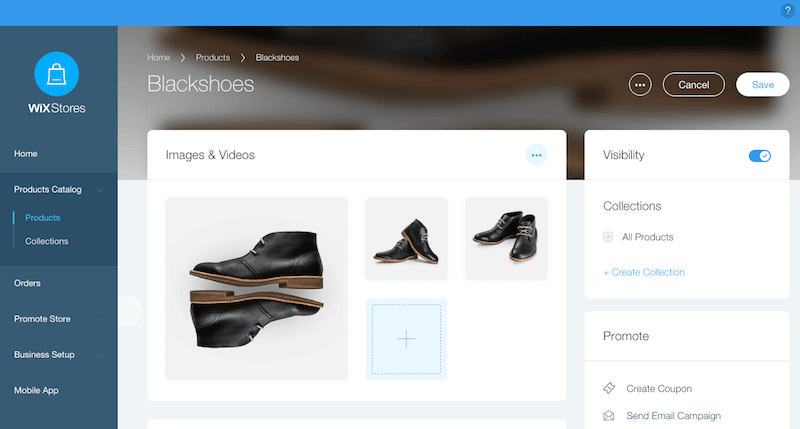
Wix’s Product Images
Both Shopify and Wix allow product videos in all their themes. Shopify also allows you to add 3D models to your products. In order to include 3D models on Wix, you’d have to add some code.
Having said that, it all changes when you start digging deeper into Shopify’s extra apps. You can find a great range of free and paying add-ons, which will enable reviews, Facebook stores, eBay item importers, and tons more. And there is one really exciting and (so far) unique Shopify feature: Augmented Reality. This allows you to use your smartphone to navigate around the product and view every little detail.
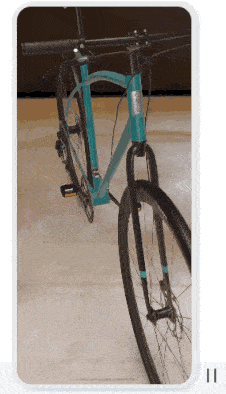
Shopify’s Augmented Reality Demo
It’s worth noting that Wix also has its own App Market; however, its 300 apps probably won’t be able to take customizations as far as Shopify’s 7,000 apps.
Long story short – while you may not be able to customize product pages out of the box as easily as with Wix, Shopify more than makes up for it with its unbeatable range of integrations and add-ons.
Winner: both Shopify and Wix present items nicely, but the Shopify apps give more options and flexibility to the platform.
Shopify – Wix 2:1
Round 4: Payment Options
There are a lot of options here, so let’s get a better overview in the following table.
| Shopify | Wix | |
|---|---|---|
| Paypal | Yes | Yes |
| Credit Card payments | Yes. Credit card fees range from 2.4% to 2.9%, plus a flat 30¢ transaction fee through Shopify Payments. No additional fees.
If you don’t/can’t use Shopify Payments, additional fees of between 0.5 – 2% will be charged for the hundreds of other gateways they support. |
Yes, through Wix Payments, Paypal, Stripe, Square and more (depending on region). Payment processing fees vary. Wix doesn’t charge additional transaction fees. |
| POS | Yes, through their own Shopify POS | Yes, through Wix POS (US only), Square and SumUp. |
| Offline payments | Yes | Yes |
| Apple Pay / Google Pay | Yes | Apple Pay only |
| Other channels | Instagram, Facebook, Pinterest, Amazon, or Etsy (via external app) | Instagram and Facebook |
| Multiple currencies | Possible, but needs a workaround. | Can display prices in different currencies, but you won’t actually be able to sell in those currencies. |
Winner: clearly, Shopify has a lot more options to sell items everywhere. Just be aware that Shopify Payments is only available in certain countries (read review). If you’re outside one of these countries, you’ll be charged up to 2% in additional transaction fees.
Shopify – Wix 3:1
Round 5: Point of Sale (POS) Capabilities
We briefly mentioned Shopify and Wix’s POS capabilities in the previous round, so let’s dig into that a bit further.
If you have a physical store, you’ll be glad to know that both Wix and Shopify offer their own POS solutions for integrating online and offline experiences. There are a few key differences, though.
Shopify POS is an app that allows you to sell in-store using just your iPhone or iPad. If you’re in the US, Canada, UK or Ireland, you can also purchase hardware such as card readers and receipt printers directly from Shopify (otherwise, you can use your own hardware, as long as it’s compatible). You can use Shopify POS in any country where Shopify has supported credit card payment providers.
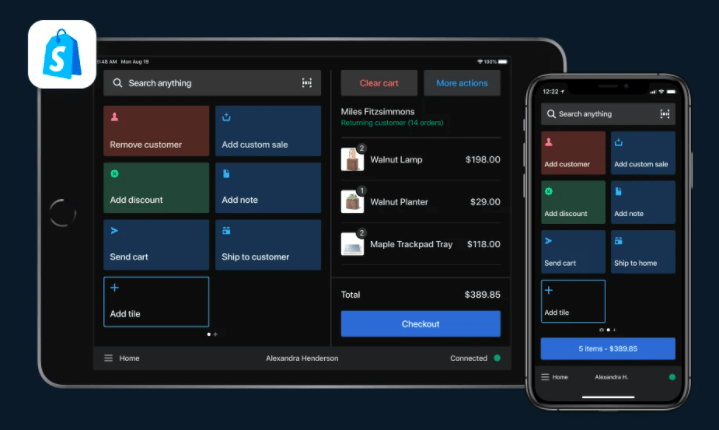
The Shopify POS app
The app is powerful, letting you sell products, customize checkout screens, accept payments, track inventory, set up customer profiles, and more. You can even send digital receipts, and allow customers to browse in-store and buy online by sending shopping carts via email.
The best news? If you opt for the POS Lite plan, it’s free. The not so good news? If you want to access advanced ecommerce functionality such as in-store pickup, staff logins and smart inventory management, the POS Pro plan will set you back $89/month. It is free if you have Shopify Plus, however.
Wix POS offers a similar list of features with their free app, with added bonuses such as local delivery, curbside pickup, and unlimited staff accounts. But, there are a few big caveats. For one thing, Wix POS is currently only available in the US, and only for supported business types. For another, you’re required to purchase Wix’s hardware as other types of hardware aren’t supported – and with POS kits starting at $550, they aren’t cheap.
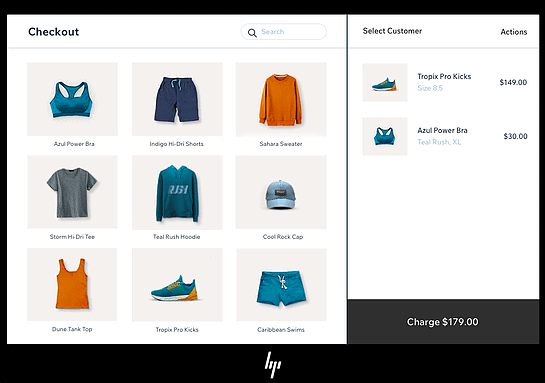
The Wix POS app
If you’re not in the US, there is a workaround available – you can sell via mobile using the Wix Owner app, and accept payments through either Square or SumUp. This isn’t really ideal for a physical store though, as you’ll be missing out on a lot of important features.
Winner: no surprises here – with more features, optional extra hardware, and wider availability, Shopify takes out the POS round. If you’re located in the US however, Wix POS might still be worth looking into because it offers free extras (e.g. local delivery, staff accounts) that Shopify will charge for.
Shopify – Wix 4:1
Round 6: Sales Channels
Of course, online selling isn’t just about selling through a store. Nowadays, ecommerce store owners know that they can significantly increase their revenue through additional online channels, such as social media and online marketplaces.
So, which of these channels do Wix and Shopify integrate with? Natively, you’ll be able to set up the following sales channels with each platform. (By ‘natively’, we mean that means that it just takes a couple of clicks to set the integration up, and you’ll automatically be able to see your Shopify store products in that channel once they’re integrated):
| Channel | Shopify | Wix |
|---|---|---|
| Yes | Yes | |
| Yes | Yes | |
| Messenger | Yes | No |
| Amazon | Yes (only for amazon.com and amazon.ca) | Yes (only for amazon.com on the Business plan) |
| eBay | No (only via the App Store) | Yes (only on Business) |
| Buy button (embeddable button that can be added to any website) | Yes | No |
| Handshake | Yes | No |
Beyond native integrations, you can also access additional sales channels via Shopify and Wix’s respective app stores. The Shopify App Store allows you to sell via Google, TikTok, Pinterest, eBay, Walmart Marketplace, LYST, Etsy and more (note that referral or subscription fees are sometimes charged).
Wix App Market doesn’t offer quite as many (we could really only find an Etsy integration, with mixed reviews). It does allow integration with Multiorders, which gives you access to additional marketplaces, although it’s probably not worth it for just the extra sales channels alone, as plans start at $49/month.
One interesting option Wix offers is the ability to turn your store into an app. (Without coding!) If a customer can access your store with just a tap, your brand is likely to stay top of mind.
In order to do this on Shopify, you’d need to hire a developer (or be one yourself!)
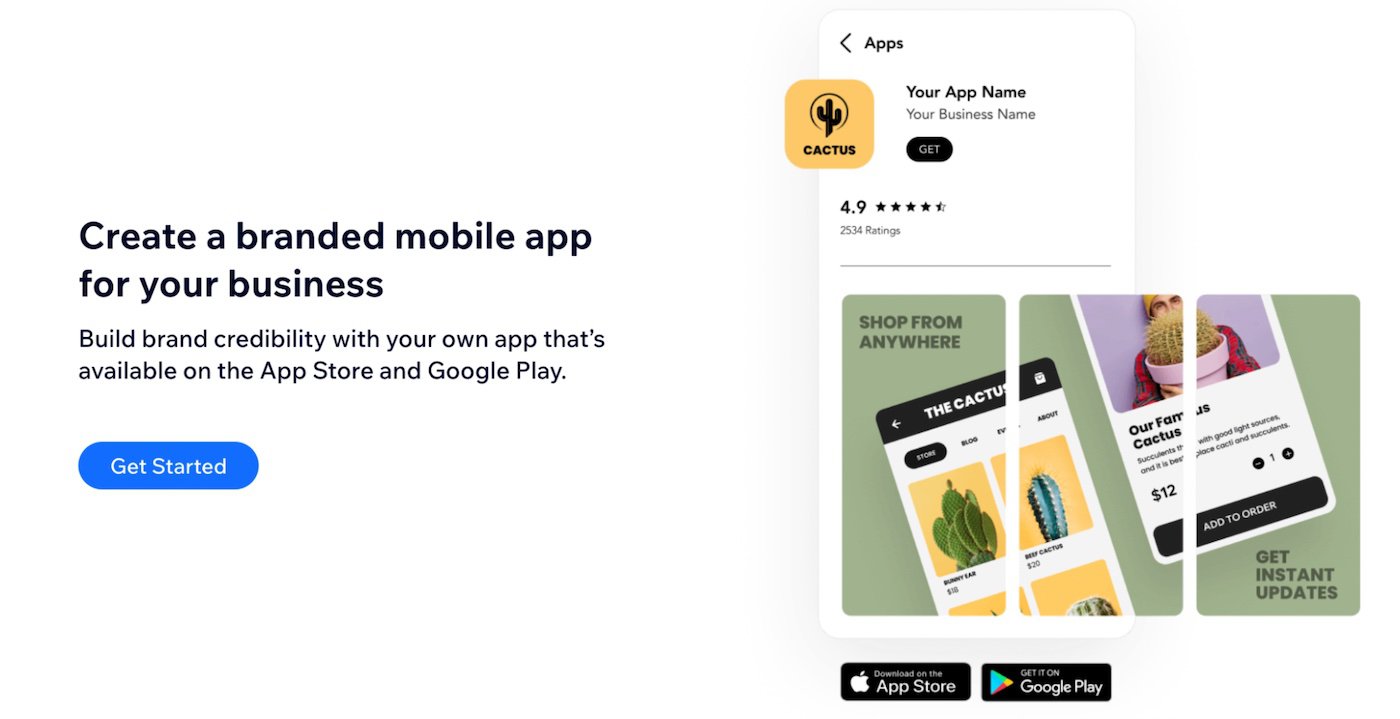
Seeing your store’s icon on their phone regularly can entice customers to shop more often.
Winner:Although we like the ability to create a custom app with Wix, Shopify wins this round. Shopify integrates with far more sales channels out of the box.
Shopify – Wix 5:1
Round 7: Customer Logins and Checkout Options
Shopify gives you great options if you want your users to register before going to the checkout. It can be mandatory, optional, or prohibited, and it’s easy for users to subscribe by filling in some basic information.
Customers can benefit from being able to access order history, order statuses, and pre-filled delivery and payment information during checkout. Orders are also retroactively associated with accounts (based on email addresses), in case a customer makes a purchase and then creates an account later on.
From your side of things, you can add users manually or import a list via CSV. You can sort them through a tag system.
Wix also lets you add a members area to your checkout process so repeat buyers save time by logging in. Much like Shopify, it also allows customers to view order status, track orders, manage addresses, view subscriptions and save payment information. One extra bonus – it lets customers view wishlist products they have saved.
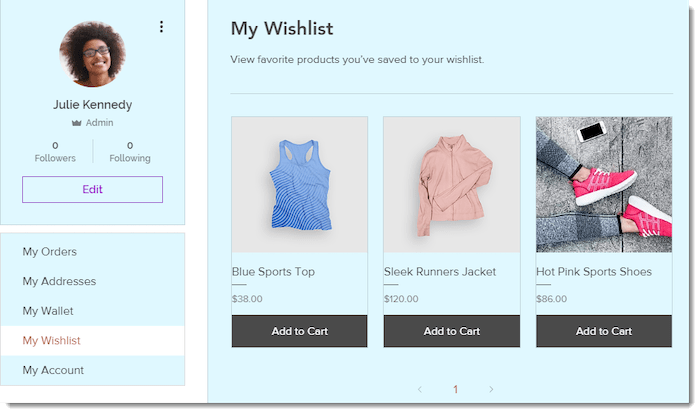
Winner: Shopify and Wix are both pretty even in their customer account features, so this round’s a draw.
Shopify – Wix 6:2
Round 8: Working with your team
If your team consists of several people, you can either share your password, or, better yet, create dedicated accounts for the people you work with.
Shopify enforces pretty strict limits: Shopify Basic only allows 2 staff accounts, the Shopify plan 5, and Shopify Advanced 15. You can also grant permissions to “collaborators” that don’t count toward your staff account limit.
What surprised us a little bit is that, an article or product someone is working on, won’t be locked for other editors. What you will see a little image of all the people currently working on a given page. But that’s easy to miss, see the image below:
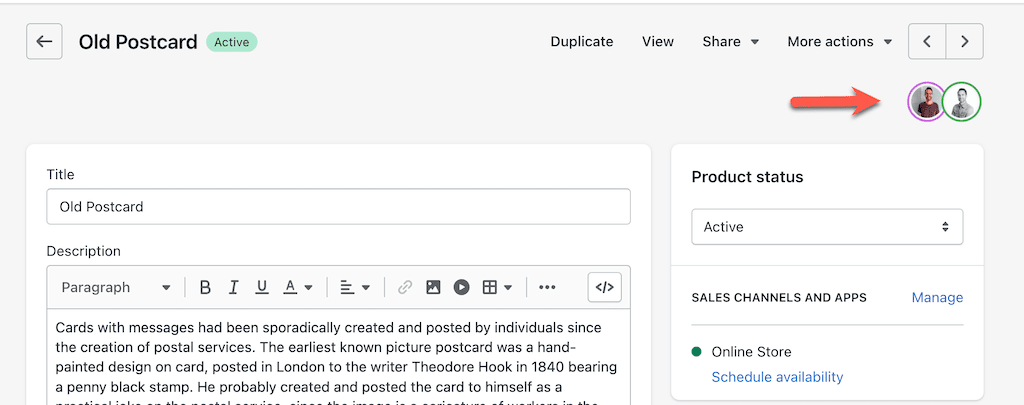
Screenshot of the Shopify editing window when two people work on a product at the same time
Now let’s talk about Wix. To be honest, I did not expect this!
With Wix you don’t need to worry about the number of staff members in any of their plans. There’s no limit! The only issue you might run into is that the backend gets slower after adding 50 or 100 staff members. But I doubt anyone would want to add this many editors anyway.
Moreover, if someone else is editing a page, Wix will show a big fat warning message!
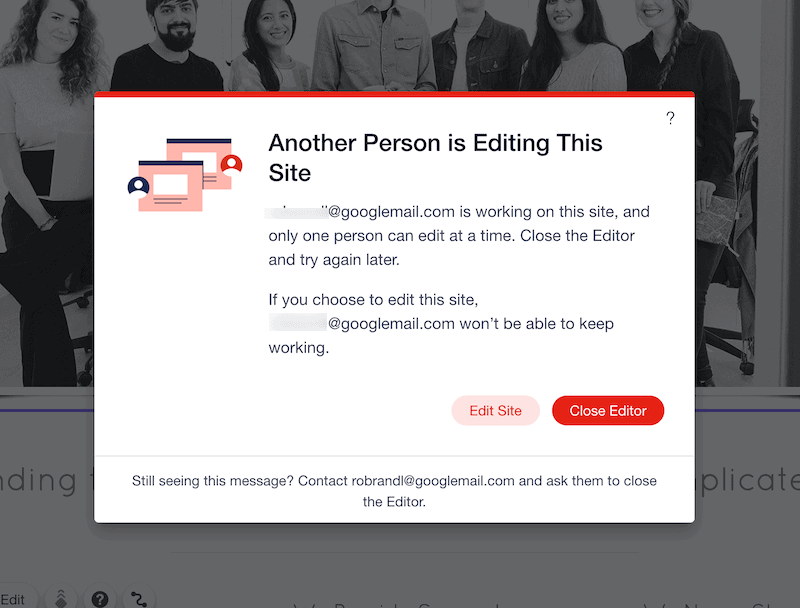
Screenshot of Wix’s warning message when two people are editing a post a the same time
Winner: to our great surprise, Wix is better for collaboration with your team members.
Shopify – Wix 6:3
Round 9: Shipping Cost Settings and Carrier Integration
Another wide range of options that’s easier to compare in a table here:
| Shopify | Wix | |
|---|---|---|
| Free shipping | Yes | Yes |
| Flat rate | Yes | Yes |
| Weight-based rate | Yes | Yes |
| Create shipping rules | Yes | Yes |
| Print and buy labels | Yes | Yes, available through USPS, and also via external providers (e.g. Shippo, ShipStation) |
| Real-time shipping | USPS, FedEx and UPS (not in the entry plan) | Only USPS (USA) and Correios (Brazil) |
| Dropshipping carriers | Native integration with Amazon fulfillment, Shipwire and Rakuten, plus app integration with DSers | Yes, via Modalyst, Spocket and 365 Dropship |
While both provide some decent options for shipping, Shopify takes it even further with its own Shopify Shipping service. Store owners in the US, Canada and Australia can offer calculated shipping rates and buy discounted shipping labels, thanks to Shopify’s partnership with carriers such as USPS, UPS, DHL Express, Canada Post and Sendle.
On top of that, there’s also the Shopify Fulfillment Network, which lets retailers in the US and Canada pack and ship products from fulfillment centers located around the US. Advantages include same-day delivery, free packaging, and discounted shipping rates.
Winner: while Wix has improved their shipping options in recent years, Shopify is still in the lead.
Round 10: Tax Settings
Shopify gives you plenty of freedom to include, or exclude taxes from the prices displayed on your store. They also support automatic tax rate calculations for the US via Shopify Tax. The downside is that it costs you 0.35% of your applicable revenue if you make more than $100k per year. You can opt out of Shopify Tax and use their legacy tax calculations tool. However, Shopify says that they don’t “guarantee the accuracy of tax calculations”.
Shopify also offers automatic calculations for the EU, UK and Canada.
Wix lets you enable or disable taxes, and set them on a region-basis. Using the free Avalara app, your Wix store will also calculate tax rates automatically. You can even define product categories for special tax rates (e.g. many EU countries charge lower VAT for food). Note that this app is only included in the Business plan ($32/month) plan and above.

Tax setting with Wix
Winner: Shopify offers more solid tax options and really helpful documentation.
Shopify – Wix 8:3
Round 11: Multilingual Capabilities
On Shopify’s pricing page you’ll see that every plan supports up to 20 languages. Great, isn’t it? Sounds like a natively integrated language tool that is … free?
Unfortunately that’s not the case at all. Shopify indeed allows you to enable additional languages, and also let visitors select their preferred language (provided your theme is compatible – all of the free themes are). These will get added as a subfolder to your URL (e.g. yourstorename.com/es).
But here’s the catch: you’ll still need to use a third-party app to be able to add/display translations, which will set you back another $20 a month on average. You can avoid using an app by uploading the translations as CSV files. But this is a very clunky solution which requires you to manually translate and configure every page in your store.
All Shopify plans allow up to 20 language versions (including the $2000 a month Shopify Plus plan).
Wix’s solution is a house-made app called Wix Multilingual. It enables you to translate your website into over 180 languages, either manually or automatically. It also lets you optimize the SEO settings for each language version. This ensures that your site ranks well in search results across different regions.
Unfortunately, Wix Multilingual still has some work to do before we can recommend it. It currently has a 2-star rating in the Wix App store, and many users complain that the only possible default language is English.
Winner: Shopify is by far better at multilingual sites, although there’s still plenty of room for improvement – it would be great if a third-party translation app wasn’t required.
Shopify – Wix 9:3
Round 12: SSL and Checkout on own domain
Winner: both Wix and Shopify offer SSL encryption with all their plans. Both ecommerce builders also allow your customers to check out on your own domain, which builds trust. This is a win-win for everyone.
Shopify – Wix 10:4
Round 13: SEO – Which one gets you faster to #1?
Both Shopify and Wix are pretty good when it comes to search engine optimization practices. You can modify your page titles, descriptions, headings, alt texts and redirects. Sitemaps are available under yourdomain.com/sitemap, and you can also add a Facebook Pixel code to track your ecommerce conversions on social media.
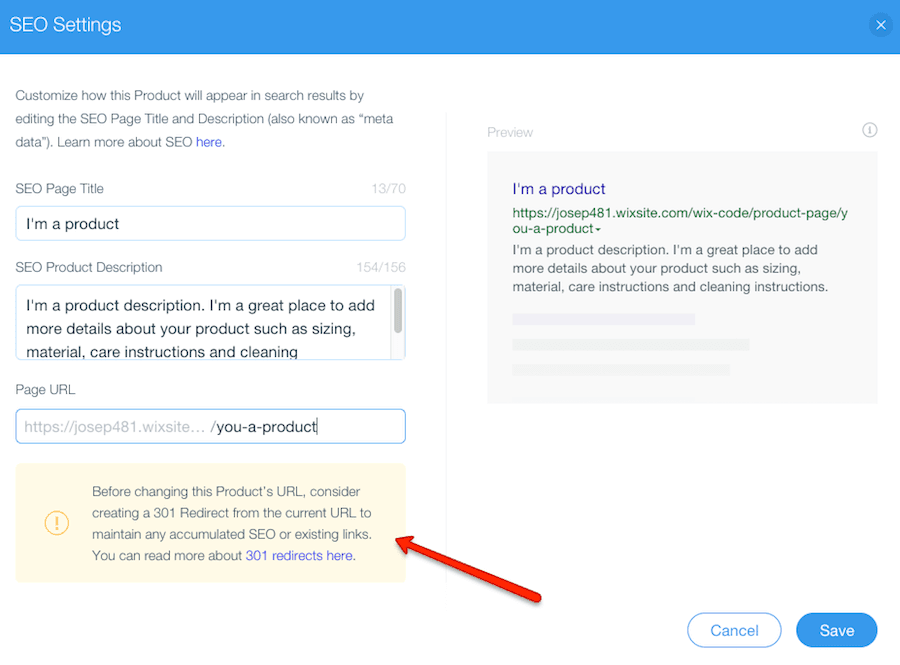
Wix Products’ SEO Options
The only strange things worth mentioning are that Shopify and Wix don’t play so nice with URLs. Shopify adds “/collections/” or “/products/” to some of them. Wix adds “/product-page/” to product pages so you cannot get full control over your URL. However, if you modify a URL, Shopify lets you click a box to automatically create a redirect from the old page. Wix only reminds you to do it.
As we mentioned earlier, Wix Stores are multilingual by default at no extra cost. The only downside there in terms of SEO is that it will use the base URL for the other languages too. So that means, for example, a Spanish page would look like this: yourstore.com/es/green-tshirts rather than yourstore.com/es/camisetas-verdes. With Shopify, you can translate that last part of the URL.
For more detailed SEO information, please consult our Wix and Shopify SEO guides.
Oh, and you will certainly want to track if your SEO efforts bear fruits. Both Shopify and Wix have basic analytics tools to track your visitors and sales included (Shopify Analytics and Wix Analytics). To get even more insights, you can also set up Google Analytics easily.
Winner: Both are fairly good, but Shopify takes the lead because of its better international SEO capabilities.
Note: neither are as good as BigCommerce though (read our BigCommerce review and our BigCommerce SEO guide for more information)!
Shopify – Wix 11:4
Round 14: Shopify or Wix, which one is faster?
Our GTmetrix test with a Shopify website gave an A rating (92%) and a score of 85 with a Pingdom test. These are very good results, especially with a loading time of between 1 and 4 seconds.
- Shopify Pingdom Test Results
- Shopify GTmetrix test results
Wix, seemed a little bit slower with a GTMetrix Test score of 65% (D ranking) and a Pingdom test result scoring 82. The load time took up to 9 seconds in some tests, which isn’t ideal for your users or SEO. Wix also didn’t score particularly well in our big speed test of 11 different website builders.
- Wix Pingdom test results
- Wix GTmetrix test results
Winner: The tests give Shopify a bit of an edge, although Wix isn’t bad either. But the point should still go to Shopify because you can access the source files to optimize the code manually (if you know how).
One additional point to add regarding speed. We’ve heard several reports that Wix’s backend tends to slow down significantly if you have to process a high number of orders.
Shopify – Wix 12:4
Round 15: Support
Shopify offers 24/7 support via chat, email and phone. Their tutorials are generally clear and helpful, and the large community means you are likely to find answers in the numerous forum threads. The cherry on the top is Shopify’s excellent marketing blog, where you can find good info on how to grow your business.

Shopify Live Chat
Wix also has a great marketing blog and well-written tutorials. Their personal support channels are also similar to Shopify’s – they offer phone support (specifically, a callback service limited to business hours), live chat (available 24/7 in English + other languages), and forums. The community is also huge, so you won’t feel alone with your problems.
Winner: After testing both options, we have to say we generally received better answers from the Shopify support. Unsurprisingly, Shopify’s customer support team is more knowledgeable about ecommerce. But, to be fair, it’s not a huge difference. Wix’s live chat support has also been pretty decent in our experience.
Shopify – Wix 13:4
Round 16: Market Place / App Store
Shopify and Wix have huge market places, with tons of apps (we counted close to 7,000 for Shopify) from third-party developers and from the platforms themselves. In both cases, some apps are free, some aren’t.
Wix’s App Market
The main difference is that Shopify’s apps are all related to ecommerce. With Wix, you are also looking at apps designed to enhance your website or blog. These can be industry-specific, for instance, related to hotels, restaurants or event planning. Both of them also offer plenty of marketing features (email marketing, live chat, social media marketing, etc.).
Winner: hard to judge here, it will depend on the kind of products you are selling. But generally speaking, Shopify’s apps are more likely to extend your store, and Wix’s apps will help your website as a whole.
Shopify – Wix 14:5
Round 17: Prices – A comparison of their premium plans
Although there is a Shopify plan called Lite, a shopping cart plugin for existing websites, at $9 a month, most people will need the Basic Shopify Plan, starting at $29 per month. For Wix, your first option is Core, which starts at $27 per month. For more in-depth comparison of the respective plans, please refer to our Shopify Pricing guide and Wix Pricing guide.
But broadly speaking, the main things to keep in mind are:
- Unless you use Shopify Payments (as mentioned above in Round 4), you will need to pay fees on all transactions, even offline sales. There are no such fees with Wix.
- Shopify limits the amount of staff accounts you can create. It’s 2,5 or 15 depending on the plan. There is no limit with Wix.
- While Shopify includes dropshipping in its Basic plan already, Wix requires you to upgrade to Business.
- Wix allows you to show carrier-calculated shipping rates in its lowest plan (using an external app). With Shopify, you have to upgrade to the costly Advanced plan.
- Shopify’s Basic plan includes Shopify Tax for automatic calculation of US sales taxes. The downside is that they charge 0.35% on your US revenue if you make more than $100k per year. With Wix you need at least the Business plan for this feature.
For a full comparison, check this handy table (prices shown are monthly costs for an annual subscription):
 |
 |
|
|---|---|---|
| For $27-29 a month | Shopify Basic ($29/month): Unlimited products. No free domain.
|
Core plan ($27/month): Unlimited physical products.
|
| For $32 a month | Business ($32/month): Adds advanced ecommerce features
|
|
| For $79 a month | Shopify (that’s what the standard plan is called)-$79/month:
|
N/A |
| For $159 a month | N/A | Business Elite ($159/month): all ecommerce features
|
| For $299 a month | Advanced Shopify ($299
/month):
|
N/A |
Winner: you can see that Wix is generally the cheaper option, but Shopify’s features are more refined most of the time. But overall, we prefer Wix’s lower prices.
Shopify – Wix 14:6
Bonus Round: AI Capabilities
Shopify Magic is a collection of free AI features designed to simplify running a business. You can use it to automatically generate content such as product descriptions and blog posts. It can also provide review summaries in the Shopify App Store to help you quickly choose the right apps for your business. (No more scanning hundreds of reviews!)
The AI feature we are most excited about is Shopify’s Sidekick. This tool is able to carry out tasks in your store using plain language instructions. For example, you could say “set up a Black Friday sale with a store-wide discount of 25%”. Sidekick would then do this for you.
Sidekick has only been released to select merchants, but we are really looking forward to testing it to see if it works as promised.
Wix is also on board with AI. In fact, you can create your whole website with Wix ADI in just a few minutes. This is a decent solution to get a site up and running quickly, but you’ll be very limited in terms of customization and features.
Wix also has a built-in tool to generate AI text for product descriptions, titles, and blog posts, but it doesn’t seem to be as seamlessly integrated as Shopify’s. It took a bit of clicking around to find, whereas Shopify has a prominent icon above text boxes.
Winner: Shopify wins this round, as its current AI features are robust and easy to use. Plus, Shopify promises to take AI to a whole different level with Sidekick.
Shopify – Wix 15:6
Our Side-by-Side Comparison
Now, let’s take a real deep look inside Wix and Shopify eCommerce. Check out the direct comparison:
|
Large & Medium Stores
|
Small Stores
|
|
|---|---|---|
| Ease of use | ||
| Choice and flexibility of templates | ||
| SEO | ||
| Product presentation | ||
| Product variants | ||
| Cart function | ||
| User ratings | ||
| Article numbers | ||
| Payment options | ||
| Sale of digital goods | ||
| SSL encryption | ||
| Customer log-in area | ||
| Coupon codes | ||
| Shipping cost settings | ||
| Dropshipping | ||
| Tax settings | ||
| Article management | ||
| Confirmation emails customizable | ||
| Importing product data | ||
| Exporting product data | ||
| E-Commerce analysis | ||
| Exporting order data | ||
| Support |
FAQ Chat Telephone |
FAQ Chat Telephone |
|
|
Basic Shopify $29 Shopify $79 Advanced Shopify $299 |
Wix Core $27 Wix Business $32 Wix Business Elite $159 |
|
Overall rating |
||
Shopify vs Wix: Conclusion
If you are just looking at the end result of this battle, Shopify clearly wins 15:6! They know ecommerce inside out as that’s what they do day in, day out.
So was it really comparing apples to oranges? Not that fast: while Shopify is the best ecommerce platform for a sizeable online store, Wix can also be the right choice for many use cases. Here’s where we would recommend either platform.
Choose Shopify if:
- You need a solution for a serious ecommerce to scale and sell everywhere around the globe.
- You need all the bells and whistles (international currencies, full range of marketplaces, etc.)
- You need multilingual stores with great SEO
- You want more payment gateways and superb POS features
- You need live support
A Wix store is best if:
- You want an easier (and cheaper) way to build an online store
- If Shopify Payments isn’t available in your country (to avoid the extra sales fee)
- The store isn’t the main goal of your website
- Creating content is the main way for you to acquire traffic (blog, landing pages etc…)
- You want more design flexibility
And there you go! Hopefully, this should clarify a few things for you.
Choosing the right ecommerce platform can feel like a really difficult decision. But don’t worry- it is possible to migrate to a different platform in the future if you change your mind. Both Wix and Shopify offer migration apps and instructions to facilitate a smooth transition between platforms.
We also have comparisons with several other platforms:
- Shopify vs BigCommerce
- Shopify vs Squarespace
- Shopify vs WooCommerce
- Wix vs Squarespace
- the other ecommerce platforms out there.
And you can also see which we platform provides the best ecommerce website builder according to our tests.
Let us know if you have any questions in the comments!
We keep our content up to date
28 Aug 2023: Small corrections
03 Aug 2023: General updates, added AI bonus round
05 Jul 2023: Update to reflect Wix's new pricing structure
29 Dec 2022: Small update regarding Wix's templates
04 Nov 2022: Updates in pricing, information about Shopify Tax
13 Sep 2022: Added comparison of staff members
23 Jun 2022: General update, revised prices
07 Apr 2022: Update for international SEO
22 Feb 2022: Smaller updates and revisions
05 Nov 2021: Wix live chat support now available
18 Oct 2021: Smaller corrections
05 Oct 2021: Multilingual feature updates (now up to 20 languages supported)
16 Apr 2021: General update, POS and sales channel comparisons added
28 Dec 2020: Wix now also supports gift cards
19 Oct 2020: New pricing structure for Wix
24 Feb 2020: Video review added
15 Jan 2020: Supported sales channels and other smaller updates
22 Aug 2019: Tax rate settings updated.
22 Apr 2019: Wix added store logins and a few other updates.
26 Oct 2018: ‘Shopify vs Wix’ Side by side comparison added.
THE BEHIND THE SCENES OF THIS BLOG
This article has been written and researched following a precise methodology.
Our methodology

